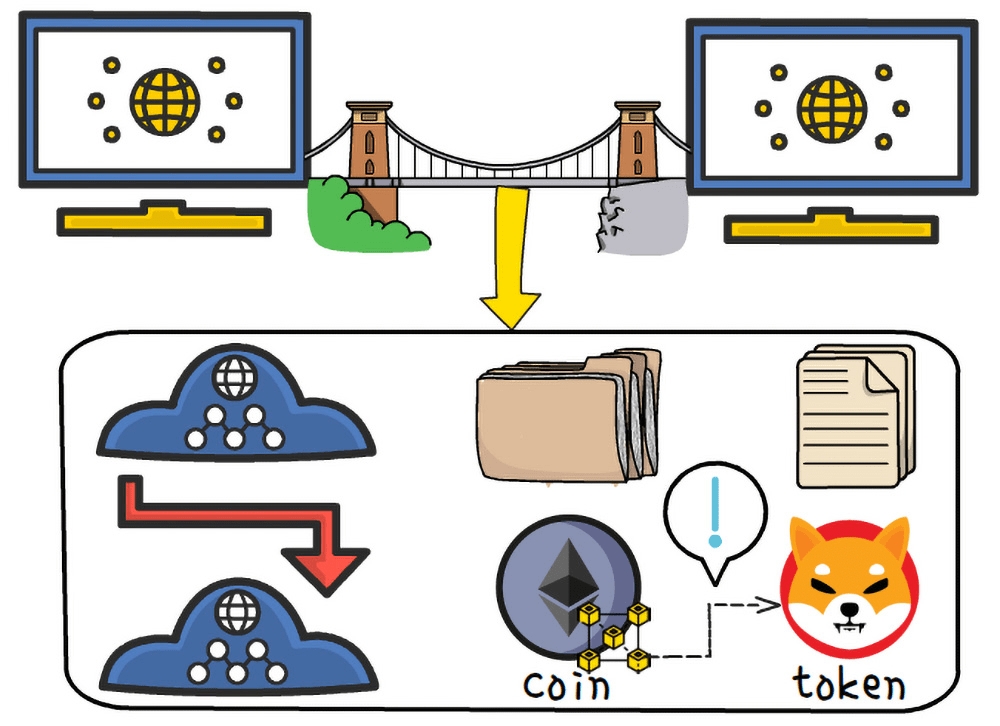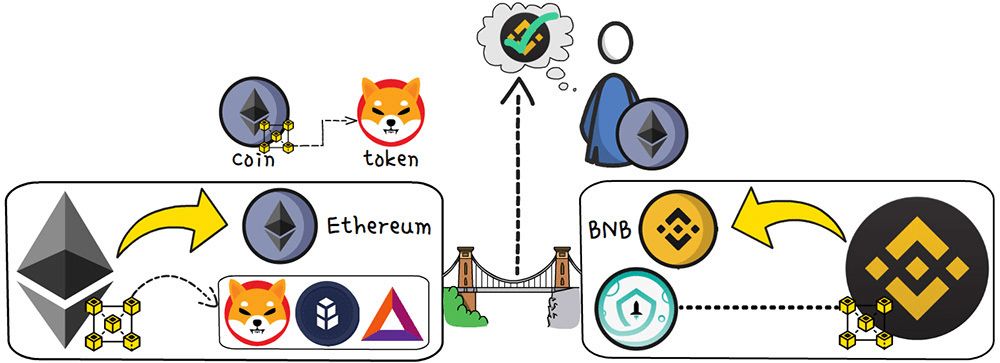The Key Notion Behind the Concept of Bridging in Crypto
In this section, I’m going to tell you what is bridging in crypto!
Imagine that you’ve decided to visit a friend, who lives in a different city. It’s a pretty long drive, so you pack up your things, and hit the road. Approaching the city where your friend’s house is located, you notice that there’s a river that needs to be crossed.
Since you’re driving a simple car, and not a futuristic car-boat, you can’t just swim over the river! However, luckily, you notice that there’s a bridge - you can use it to cross over, and meet your friend on the other side. From a somewhat philosophical point of view, this is how blockchain bridges work, too!
In this section, we’re going to answer the question - what is bridging in crypto? Specifically, I’m going to tell you about the problem that many blockchains face, what is crypto bridging & how it can help eliminate that problem, and we’ll also talk about the best blockchain bridges and how to spot them, too!
Now, let’s get to it!

Video Explainer
Video Explainer: The Key Notion Behind the Concept of Bridging in Crypto
Reading is not your thing? Watch the "The Key Notion Behind the Concept of Bridging in Crypto" video explainer
What is a Crypto Bridge? (Explained with Animations)


The Communication Problem of Blockchains
So, for starters, allow me to elaborate on the example I gave in the introduction, as we move on to discuss what are blockchain bridges, and how do they work.
In the example, both you and your friend represent two different blockchain networks. For the sake of this example, let’s say, Bitcoin and Ethereum. As you might be aware, both of these blockchains are very different from one another!

Ethereum is this super-smart global computer that allows its users to create and participate in smart contracts, decentralized finance (or, DeFi), and a variety of other revolutionary activities. On the flip side, Bitcoin is usually seen as the “dumb” blockchain - essentially, it has no “smart” functionality, and is mostly only used as a store of value.
Note that, if some of the terms I’ve mentioned earlier aren’t familiar to you, do make sure to check out other sections in the Crypto 101 Handbook - you'll find dedicated sections on all of those topics! Moving on, though, you might ask - so, where’s the problem?
Well, what if you want to, say, participate in some sort of a cool, new dApp on Ethereum, but you’re only holding Bitcoin? This is where blockchain bridges come in to save the day!
You see, this is kind of the biggest problem that all blockchain networks face, in general - they have a pretty difficult time communicating with one another! Since many of these protocols are built using very different technology, they aren’t able to connect with each other - it’s like trying to install an Xbox game on your personal computer!
What is a Blockchain Bridge, and Where is it Used?
Moving on, in order to help different blockchain networks connect and “communicate” with one another, you need bridges. To answer the question of what is bridging in crypto simply, you can think of these bridges as special connections that allow two completely different blockchains to share data, coins & tokens, and various other information.

Notice how I mention “coins & tokens” - this part is very important! If you’d like an in-depth explanation of what are the differences between crypto coins and tokens, check out this section - for now, though, just know that crypto coins have their own blockchains, while cryptocurrency tokens are built on the blockchains of other coins.
Feeling confused? Well, look - let’s illustrate that with an example.

Once again, let’s look at Ethereum - this is a blockchain that has a native coin of its own, by the same name. However, Ethereum is also home to a huge variety of different tokens, too - the Shiba Inu token, Bancor, the Basic Attention Token, and so on.
Then, you have another network, such as the Binance Smart Chain. The native coin of this blockchain is BNB. Binance Smart Chain also has a variety of tokens built on it, too.
Where do blockchain bridges come in? Well, think about it this way - what would happen if you wanted to use your Ethereum coins or tokens on the Binance Smart Chain? Traditionally, you couldn’t - these are two completely different networks! However, crypto bridging allows you to do just that!
Up until this point, we’ve talked about some pretty vague examples of blockchain bridging. Let’s change that - allow me to give you a very specific example of what is bridging in crypto, and how you can use it, too!
Imagine that you’ve found an awesome yield-earning platform. The premise behind it is very simple - you put in some cryptocurrency that you hold, and then earn a passive interest over time. This platform supports a wide list of cryptocurrencies, so you start browsing and looking for the best numbers.
During your research, you notice something interesting - if you were to deposit your ETH coins into it, you would earn a 1% annual yield. However, if you would instead deposit ETH coins that are based on the Binance Smart Chain, that percentage would double!

So, all that you need to do now is find a blockchain bridge, exchange your ETH coin to Binance Smart Chain Ethereum, and start earning a passive yield!
An alternative example that you could think about would have to do with cryptocurrency lending and borrowing. This can be done in two types of platforms - centralized institutions, and some anonymity-preserving, decentralized applications. In most cases, however, crypto lending and borrowing are considered to be a form of DeFi, or decentralized finance.

Most modern blockchain networks are advanced enough to allow their coin or token holders to participate in lending and borrowing. Older blockchains (such as Bitcoin and Dogecoin), however, do not - in order to borrow or lend them out, you would need to bridge these assets on special applications that would allow you to do so, and that are based on other, “smarter” networks. Makes sense?
Best Blockchain Bridges
Now, I admit - this is a pretty complex topic to tackle! That being said, though, now that you know what is bridging in crypto, and where these bridges are used, in the first place, there’s one more thing that I’d like to discuss - the best blockchain bridges, and how to find them!
First things first - this won’t be a list of blockchain bridges for you to check out. Instead, I’d like to tell you about the types of bridges that you might come across, and what to look for with each of those types, as well.
So, to start things off, you should note that there are two major types of blockchain bridges - centralized, and decentralized ones. They are both very preference-based, and will thus suit different people, too. However, if you’re just starting out, I’d recommend you go with the centralized bridges - these are much simpler to use and get into, in general.

Essentially, some of the most popular centralized crypto bridges are those that are located on trusted and well-known crypto exchanges. These bridges work with the help of exchange-based liquidity pools. Now, it’s a huge topic, in of its own, so if you’re not familiar with it, I highly recommend reading a section about liquidity pools.
Put simply, though, the exchange houses two different pools - say, that of Bitcoin, and Ethereum-equivalent of BTC coins. When you visit the centralized exchange, and deposit your Bitcoin into it, you will receive an equivalent amount of Ethereum-based BTC. Your original BTC coins are locked up in the first pool - you can exchange your newly-acquired ETH-Bitcoins for your original coins at any point in time!
The process looks pretty complex, when you put it that way, but swapping your crypto like this is actually pretty simple - many centralized institutions have special interfaces that allow you to do so in a clear and beginner-friendly manner.
Now, if you decide to use the best centralized blockchain bridges, just keep in mind that you will need to really trust the platform that you’ve chosen! I mean, think about it this way - it’s like you meeting a stranger, and them telling you: “Hey, if you give me your money, I promise that I won’t steal it from you, and that it won’t magically disappear one day!”.
Well, I do admit that this is a bit of an exaggeration, but the general idea remains the same - you should use only the most-trustworthy cross-chain bridges!
The second type of crypto bridges that you can encounter are decentralized ones. These bridging options are quite a bit more complex than their centralized counterparts, and they do come with their own benefits and drawbacks, too.
Decentralized bridges work with the help of smart contracts. Once you deposit your cryptocurrency into a smart contract, it gets locked up, and you are automatically paid out the equivalent crypto, immediately. Since your original coins get locked up in the contract, there are no new cryptos coming into the market, and thus, there aren’t any complex inflationary problems being caused, either.
Decentralized cross-chain bridges are wonderful for anyone who wants to remain anonymous in their crypto swapping ventures. However, this comes with the drawback of these bridges often being less-secure than centralized ones. So, if you’re adamant about using a smart contract-powered crypto bridging solution, you should take the time and do some thorough research!
That concludes our discussion of what bridging in crypto is. As you’ve probably gathered by now, bridging is a very important part of the cryptocurrency world! It is thus equally important that you educate yourself on the topic.










